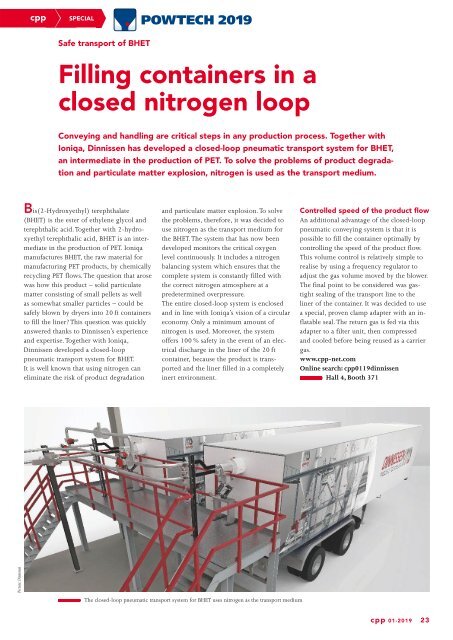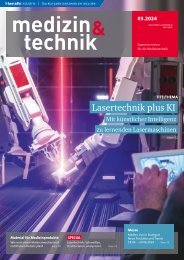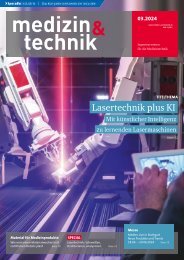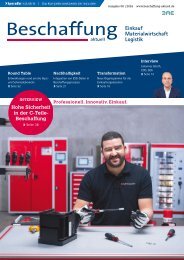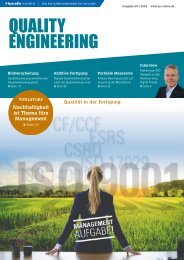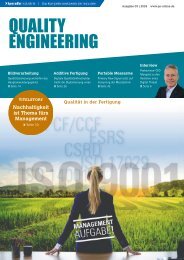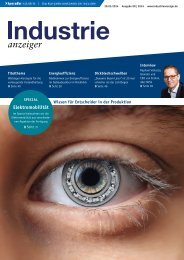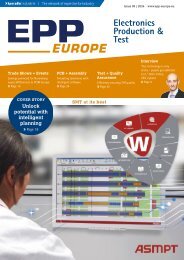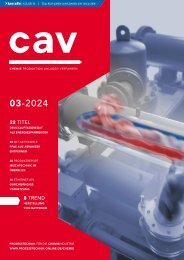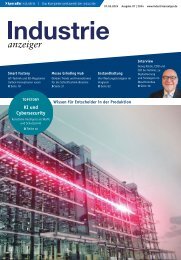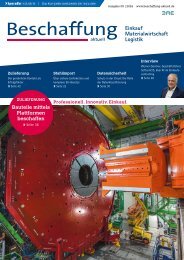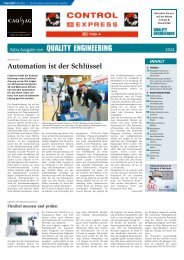cpp – Process technology for the chemical industry 01.2019
The journal cpp - Process technology for the chemical industry reports about processes, plants, apparatus and components for the chemical and pharmaceutical industry. Further topics are IT technologies, industry 4.0, digital production, MSR and automation technology and process analysis technology. The content spectrum is rounded off by explosion protection, plant safety, occupational health and safety, maintenance, site management and energy management.
The journal cpp - Process technology for the chemical industry reports about processes, plants, apparatus and components for the chemical and pharmaceutical industry. Further topics are IT technologies, industry 4.0, digital production, MSR and automation technology and process analysis technology. The content spectrum is rounded off by explosion protection, plant safety, occupational health and safety, maintenance, site management and energy management.
Create successful ePaper yourself
Turn your PDF publications into a flip-book with our unique Google optimized e-Paper software.
<strong>cpp</strong><br />
SPECIAL<br />
Safe transport of BHET<br />
Filling containers in a<br />
closed nitrogen loop<br />
Conveying and handling are critical steps in any production process. Toge<strong>the</strong>r with<br />
Ioniqa, Dinnissen has developed a closed-loop pneumatic transport system <strong>for</strong> BHET,<br />
an intermediate in <strong>the</strong> production of PET. To solve <strong>the</strong> problems of product degradation<br />
and particulate matter explosion, nitrogen is used as <strong>the</strong> transport medium.<br />
Bis(2-Hydroxyethyl) terephthalate<br />
(BHET) is <strong>the</strong> ester of ethylene glycol and<br />
terephthalic acid. Toge<strong>the</strong>r with 2-hydroxyethyl<br />
terephthalic acid, BHET is an intermediate<br />
in <strong>the</strong> production of PET. Ioniqa<br />
manufactures BHET, <strong>the</strong> raw material <strong>for</strong><br />
manufacturing PET products, by <strong>chemical</strong>ly<br />
recycling PET flows. The question that arose<br />
was how this product <strong>–</strong> solid particulate<br />
matter consisting of small pellets as well<br />
as somewhat smaller particles <strong>–</strong> could be<br />
safely blown by dryers into 20 ft containers<br />
to fill <strong>the</strong> liner? This question was quickly<br />
answered thanks to Dinnissen’s experience<br />
and expertise. Toge<strong>the</strong>r with Ioniqa,<br />
Dinnissen developed a closed-loop<br />
pneumatic transport system <strong>for</strong> BHET.<br />
It is well known that using nitrogen can<br />
eliminate <strong>the</strong> risk of product degradation<br />
and particulate matter explosion. To solve<br />
<strong>the</strong> problems, <strong>the</strong>re<strong>for</strong>e, it was decided to<br />
use nitrogen as <strong>the</strong> transport medium <strong>for</strong><br />
<strong>the</strong> BHET. The system that has now been<br />
developed monitors <strong>the</strong> critical oxygen<br />
level continuously. It includes a nitrogen<br />
balancing system which ensures that <strong>the</strong><br />
complete system is constantly filled with<br />
<strong>the</strong> correct nitrogen atmosphere at a<br />
predetermined overpressure.<br />
The entire closed-loop system is enclosed<br />
and in line with Ioniqa’s vision of a circular<br />
economy. Only a minimum amount of<br />
nitrogen is used. Moreover, <strong>the</strong> system<br />
offers 100 % safety in <strong>the</strong> event of an electrical<br />
discharge in <strong>the</strong> liner of <strong>the</strong> 20 ft<br />
container, because <strong>the</strong> product is transported<br />
and <strong>the</strong> liner filled in a completely<br />
inert environment.<br />
Controlled speed of <strong>the</strong> product flow<br />
An additional advantage of <strong>the</strong> closed-loop<br />
pneumatic conveying system is that it is<br />
possible to fill <strong>the</strong> container optimally by<br />
controlling <strong>the</strong> speed of <strong>the</strong> product flow.<br />
This volume control is relatively simple to<br />
realise by using a frequency regulator to<br />
adjust <strong>the</strong> gas volume moved by <strong>the</strong> blower.<br />
The final point to be considered was gastight<br />
sealing of <strong>the</strong> transport line to <strong>the</strong><br />
liner of <strong>the</strong> container. It was decided to use<br />
a special, proven clamp adapter with an inflatable<br />
seal. The return gas is fed via this<br />
adapter to a filter unit, <strong>the</strong>n compressed<br />
and cooled be<strong>for</strong>e being reused as a carrier<br />
gas.<br />
www.<strong>cpp</strong>-net.com<br />
Online search: <strong>cpp</strong>0119dinnissen<br />
Hall 4, Booth 371<br />
Picture: Dinnissen<br />
The closed-loop pneumatic transport system <strong>for</strong> BHET uses nitrogen as <strong>the</strong> transport medium<br />
<strong>cpp</strong> 01-2019 23


